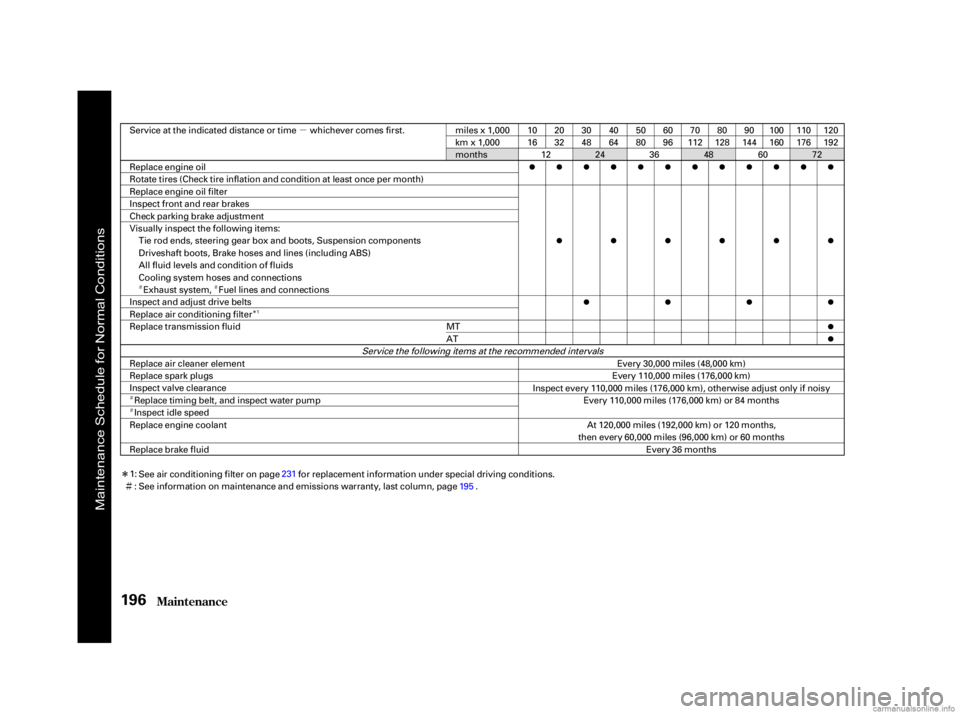Page 10 of 323

Your car is equipped with many
features that work together to
protect you and your passengers
during a crash.
Some saf ety f eatures do not require
anyactiononyourpart.These
include a strong steel f ramework
that forms a safety cage around the
passenger compartment; f ront and
rear crush zones that are designed to
crumple and absorb energy during a
crash; a collapsible steering column;
and seat belt tensioners that
automatically tighten the front seat
belts in the event of a crash.
CONT INUED
Driver and Passenger Saf ety
Your Car’s Saf ety Features
7
( (4
4) )
(
( 5
5) ) (
(
6
6) )
(
(2
2) )
(
(
8
8) )
(
( 9
9) )
(
(
8
8) )
(
( 7
7) ) (
(
1
10 0)) (
(1
1) ) (
(3
3) )
(
( 2
2) ) (
(
7
7) )
(
(1
1) ) S
Sa affe
et tyy C
Caagg e
e
(
( 2
2) ) C
Cr ruu s
shh Z
Zo
on
ne
e
(
( 3
3) ) S
Se eaattss &
& S
Seeaatt--B
Ba acckks s
(
( 4
4) ) H
H e
eaadd R
Reessttrraai inn t
tss
(
( 5
5) ) C
Co ol
lllaap p s
siibb l
lee S
Stteee erriinn g
g C
Cool
luu m
m n
n
(
( 6
6) ) S
Se eaatt B
Be elltts s
(
( 7
7) ) F
Frroo n
nt
t A
A i
irrb b a
agg s
s
(
( 8
8) ) S
Si idd e
e A
Ai
irrb b a
agg s
s (
(O
Op pt
tiioo n
na
all))
(
( 9
9) ) S
Se eaatt B
Be elltt T
Te
enn s
siioo n
ne
errss
(
( 1
10 0)) D
D o
oo
or
r L
Loo c
ckks s
Page 14 of 323

How you adjust your seats and seat-
backs can also affect your safety. For
example, sitting too close to the
steering wheel or dashboard
increases the risk of you or your
passenger being injured by striking
theinsideof thecar,orbyan
inf lating airbag.
Reclining a seat-back too f ar reduces
the seat belt’s ef f ectiveness and
increases the chance that the seat’s
occupant will slide under the seat
belt in a crash and be seriously
injured.Head restraints can help protect you
f rom whiplash and other injuries. For
maximum protection, the back of
your head should rest against the
center of the head restraint.
Your car’s seats are designed to keep
you in a comf ortable, upright
position so you can take f ull
advantage of the protection offered
by seat belts and the energy
absorbing materials in the seats.
Move the f ront
seats as far back as possible, and
keep adjustable seat-backs in an
upright position whenever the car is
moving. Keeping your doors locked reduces
thechanceof beingthrownoutof
the car during a crash. It also helps
prevent occupants f rom accidentally
opening a door and f alling out, and
outsiders f rom unexpectedly opening
your doors.
Seats & Seat-Backs
Head RestraintsDoor L ocks
What you should do:
Driver and Passenger Saf ety
Your Car’s Saf ety Features
11
Page 65 of 323

This light has two f unctions:This light normally comes on f or a
f ew seconds when you turn the
ignition switch ON (II), and when
the ignition switch is turned to
START (III). If this light comes on at
any other time, there is a problem in
theABS.If thishappens,takethe
cartoyourdealertohaveitchecked.
With the light on, your car still has
normal braking ability but no anti-
lock. For complete inf ormation, see
page .
If this light comes on when the
engine is running, the battery is not
being charged. For complete
inf ormation, see page .
The engine can be severely damaged
if this light f lashes or stays on when
the engine is running. For complete
inf ormation, see page .
This indicator comes on when you
turn the ignition switch ON (II). It
is a reminder to check the parking
brake. Driving with the parking
brake not f ully released can
damage the brakes and tires.
If the indicator remains lit after
you have f ully released the
parking brake while the engine is
running, or if it comes on while
driving, it can indicate a problem
in the brake system. For complete
inf ormation, see page .
1.
2.
276
275 279187
Only on models equipped with ABS (see
page ) 185
Parking Brake
and Brake
System
Indicator Anti-lock Brake
System (A BS)
Indicator
Charging System
Indicator
L ow Oil Pressure
Indicator
Indicator L ights
Inst rument s and Cont rols62
U.S. Canada
U.S. Canada
Page 176 of 323

This section gives you tips on
starting the engine under various
conditions, and how to operate the
5-speed manual and automatic
transmissions. It also includes impor-
tant inf ormation on parking your car,
and the braking system.........................
Preparing to Drive .174
.......................
Starting the Engine .175
Starting in Cold Weather ....................
at High Altitude .175
....
5-speed Manual Transmission . 176
.....
Recommended Shif t Points . 177
..............
Engine Speed Limiter . 177
..............
Automatic Transmission . 178
.
Shif t Lever Position Indicator . 178
................
Shif t Lever Positions . 179
..............
Engine Speed Limiter . 181
....................
Shif t Lock Release . 182
...........................................
Parking .183
..............................
Parking Tips .183
.....................
The Braking System .184
.............
Brake Wear Indicators . 184
...............
Brake System Design . 185
.......................
Anti-lock Brakes .185
Important Saf ety .........................
Reminders .186
........................
ABS Indicator .187
...............
Driving in Bad Weather . 188
...........................
Towing a Trailer .189
Driving
Driving173
Page 188 of 323

CONT INUED
ABS helps to prevent the wheels
f rom locking up and skidding during
hard braking, allowing you to retain
steering control.
The hydraulic system that operates
the brakes has two separate circuits.
Each circuit works diagonally across
the vehicle (the lef t-f ront brake is
connected with the right-rear brake,
etc.). If one circuit should develop a
problem, you will still have braking
at two wheels.
this defeats the
purpose of the ABS. Let the ABS
work f or you by always keeping f irm,
steady pressure on the brake pedal
as you steer away from the hazard.
This is sometimes ref erred to as
You will f eel a pulsation in the brake
pedal when the ABS activates, and
you may hear some noise. This is
normal, it is the ABS rapidly
pumping the brakes.
When the f ront tires skid, you lose
steering control; the car continues
straightaheadeventhoughyouturn
the steering wheel. The ABS helps to
prevent lock-up and helps you retain
steering control by pumping the
brakes rapidly; much f aster than a
person can do it. The U.S. EX model has an Anti-lock
Brake System (ABS) as standard
equipment. It is optional on Canadian
LX model.
‘‘stomp and steer.’’
Brake System Design
A nti-lock BrakesYou should never pump the
brake pedal,
Driving
The Braking System
185
F Fr roo n
nt
t
Page 189 of 323

on loose or
uneven surfaces, such as gravel or
snow, than a vehicle without anti-
lock. Slow down and allow a greater
distance between vehicles under
those conditions.
it
only helps with steering control
during braking. You should always
maintain a saf e f ollowing distance
f rom other vehicles.
such as trying to take a
corner too f ast or making a sudden
lane change. Always drive at a safe,
prudent speed f or the road and
weather conditions.
Always steer moderately
when you are braking hard. Severe
or sharp steering wheel movement
can still cause your car to veer into
oncoming traffic or off the road.
Activation varies with the amount of
traction your tires have. On dry
pavement, you will need to press on
thebrakepedalveryhardbeforeyou
activate the ABS. However, you may
feel the ABS activate immediately if
you are trying to stop on snow or ice.
The Braking System
Driving
A vehicle with A BS may require a
longer distance to stop
A BS does not reduce the time or
distance it takes to stop the car,
A BS will not prevent a skid that
results f rom changing direction
abruptly,
A BS cannot prevent a loss of
stability.Import ant Saf et y Reminders
186
Page 190 of 323
�Î
�Î�Î
�Î
The ABS is self -checking. If anything
goes wrong, the ABS indicator on
the instrument panel comes on (see
page ). This means the anti-lock
f unction of the braking system has
shut down. The brakes still work like
a conventional system without anti-
lock, providing normal stopping
ability. You should have the dealer
inspect your car as soon as possible.
62
The Braking System
Driving
A BS Indicat or
187
U U.
.SS. .i
inn d
di
icca at too r
r s
shh o
ow
wn n
A
A
B
BSS I
INND DI
ICCA A T
TO
OR R
Page 199 of 323

�µ
�Î�Ì
�Ì�Ì
�Î
�Ì
�Ì
Maint enance196
Service at the indicated distance or time whichever comes first. miles x 1,000
km x 1,000
months 10
16
50
8070
112 110
176
Service the following items at the recommended intervalsEvery 30,000 miles (48,000 km)
Every 110,000 miles (176,000 km)
Inspect every 110,000 miles (176,000 km), otherwise adjust only if noisy Every 110,000 miles (176,000 km) or 84 months
At 120,000 miles (192,000 km) or 120 months,
then every 60,000 miles (96,000 km) or 60 months Every 36 months
20
32
40
64 80
128 100
160
60
96
30
48 90
144 120
192
See information on maintenance and emissions warranty, last column, page . See air conditioning filter on page for replacement information under special driving conditions.
Replace engine oil
Rotate tires (Check tire inflation and condition at least once per month)
Replace engine oil filter
Inspect front and rear brakes
Check parking brake adjustment
Visually inspect the following items:
Tie rod ends, steering gear box and boots, Suspension components
Driveshaft boots, Brake hoses and lines (including ABS)
All fluid levels and condition of fluids
Cooling system hoses and connectionsExhaust system, Fuel lines and connections
Inspect and adjust drive belts
Replace air conditioning filter
Replace transmission fluid
Replace air cleaner element
Replace spark plugs
Inspect valve clearance Replace timing belt, and inspect water pump
Inspect idle speed
Replace engine coolant
Replace brake fluid 24
4872
12 3660
MT
AT
1: : 195
231
1
Maintenance Schedule for Normal Conditions